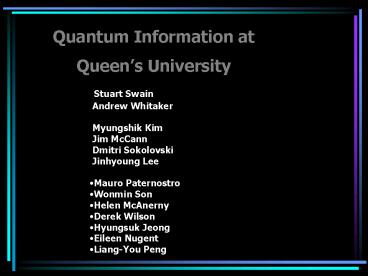Nonlinear Atom Optics - PowerPoint PPT Presentation
1 / 30
Title:
Nonlinear Atom Optics
Description:
Breather. Atoms in spheroidal traps. Atoms trapped by external fields in a pancake shape cloud ... easy but complicated. Hybrid and dark states affect process ... – PowerPoint PPT presentation
Number of Views:79
Avg rating:3.0/5.0
Title: Nonlinear Atom Optics
1
Quantum Information at Queens University
- Stuart Swain
- Andrew Whitaker
- Myungshik Kim
- Jim McCann
- Dmitri Sokolovski
- Jinhyoung Lee
- Mauro Paternostro
- Wonmin Son
- Helen McAnerny
- Derek Wilson
- Hyungsuk Jeong
- Eileen Nugent
- Liang-You Peng
2
Quantum Information at Queens
- Quantum Algorithms
- Optical realisation of QIP
- Complementarity and Fidelity
- Decoherence and non-Markovian processes
- Many-body entanglement and
- nonlocality for continuous variable states
- Solid-state realisation of QIP
- Nonlinear Atom Optics
- Laser cooling
- Coherent control
- Squeezed light and matter
3
Nonlinear Atom OpticsMode Conversion in
Trapped Atomic Condensates
Jim McCann, Eileen Nugent, Dermot McPeake
- Coherent atom excitations
- Wave mixing
- Mode conversion in traps
- Mode conversion in lattices
4
Condensate basics
- Macroscopic quantum state
- Bosons high occupation
- High phase-space density
- Nonlinearity
UK Cold Atom Network Ed Hinds (ICSTM) Charles
Adams (Durham) Labs St. Andrews, Strathclyde,
Glasgow, Durham, Manchester, Oxford,
UCL, ICSTM, NPL, Sussex
5
Atom Optics and Quantum Information
- Coherent matter waves
- Macroscopic quantum state
- Manipulation by external fields
- beams, microtraps, lattices, lenses,
chips - Tunable interactions (entanglement)
- kinetic and potential energy control
- Control Superfluid lt-gt Insulator
- Coherent atom device as
- register, amplifier or reservoir
6
Cold atom engineering
- Hinds and Hughes (1999) J. Phys. D 32 119
- Atoms in microtraps and on chips (ICSTM)
Reichel and Haensch (MPQ, Garching)
Chikkatur et al (MIT) 2002 Science 296, 2193
7
First-order coherence
Andrews et al (1997) Science 275
637-41 Observation of interference between two
Bose condensates
8
Spatial coherence millimetres
I. Bloch, T. W. Haensch T. Esslinger, Nature
403, p166 (2000)
9
Coherent output coupling
Coherent splitting of condensate with optical
Bragg scattering
Kozuma et al (1999) Phys. Rev. Lett. 82 871
10
Nonlinear atom optics
Deng et al (NIST) Nature 398, 218 - 220 (1999)
Four-wave mixing
11
Nonlinear atom optics in traps
Single quasiparticle excitations (low temperature)
i
f
V
i
k
Wave-mixing collisions
f
j
Wave-mixing processes include Sum-frequency
mixing, second harmonic generation, parametric
down conversion
12
Collective excitations in traps
10 ms snapshots
Miesner et al Science 279, 1005 (1998)
13
Quantized modes forAtoms in spherical traps
Experiment (JILA) Cornell Wieman et al.
Theory (Oxford/NIST) Burnett Clark et al.
Breather
Quadrupole
Changing the axial confinement creates shape
oscillations of the cloud well-defined quantized
modes
14
Atoms in spheroidal traps
Atoms trapped by external fields in a pancake
shape cloud
Breather
Quadrupole
k
2k
f
k
Resonance near
15
Hechenblaikner Foot et al., PRL 84 , 2056
(2000)
20,000 atoms of Rb
- Second Harmonic Generation
- observed near phase matching
- conditions
- Component at 2? in the
- axial direction
- Observation of radial freezing
- at phase matching resonance
16
Bogoliubov model
Many-body Hamiltonian
Wavefunction condensate thermal component
where
17
Thermal component expanded in quasi-particle
functions
where
Eigenvalues give excitation frequencies ?
Ideal gas modes Oscillator (Traps) Bloch
(Lattices)
Interacting gas modes quasiparticle states
18
Wave mixing in Condensates
k
2k
k
f
Optics
Coupling strengthscattering amplitude
(Morgan,Burnett et al)
19
Spectrum of excitations (Rb)
Bogoliubov and hydrodynamic (inset) frequency
predictions of the lowest four even parity, m
0, excitations.
20
Hybrid Bogoliubov modes
mode amplitudes
?1.35 Modes have characteristic surface and
monopole nature. ?1.60, 1.65 Modes hybridize at
the anticrossing with the result that one of them
has zero overlap with the quadrupole l
2. ?1.75 The modes regain their characteristic
form.
21
Hybrid mode coupling
dark state
2-state model
22
Coupling to shape oscillations
radial
Width
axial
time
23
Conversion efficiency
Axial width
Radial width
Red -gt Resonance -gt Blue
24
Spectrum at phase matching
Second harmonic doublet
fundamental
third harmonic
Down conversion
25
Mode conversion in lattices
- intersecting beams of light cool atoms
- atoms trapped at dark spots
26
Superfluid-Insulator transition
(1) tunneling dominated superfluid delocalized
state, coherent state
(2) interaction dominated insulator localized
state, Fock (number) state
Haensch et al (2002) Nature 415 39-44
27
Mode conversion in lattices
Bose-Hubbard model Jaksch et al (1998) Phys.
Rev. Lett. 81, 3108.
J tunneling Uinteraction
Tight-binding functions, small occupation
28
Current work wave mixing in lattices
Bogoliubov spectrum
Bloch wave spectrum
Energy
Energy
Second Harmonic
Condensate density
Height of barrier between wells
Louis et al (2003) PRA 67 013602
29
Lattice output reading
Coherent emission from lattice loaded with
condensate interference pulses in region A.
Pulse period 1 msec h/mgDz
30
Conclusions
- Qualitative agreement theory/experiment
- Mode conversion in trapped condensates
- easy but complicated
- Hybrid and dark states affect process
- Third harmonic generation, down conversion and
four-wave mixing - Control of coherent excitation within trap more
difficult than it appeared - Lattice mode mixing is even more complex































